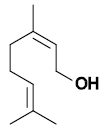Nerol
Nerol is a monoterpene and a significant component of the essential oil of several plants, including lemongrass, hops, and neroli. It is a colorless liquid and exhibits a sweet rose-like aroma.
Chemistry[edit | edit source]
Nerol shares its molecular formula, C10H18O, with geraniol and citral. It is a stereoisomer of geraniol, differing only in the geometry of the double bond. Nerol is soluble in water and can be obtained by fractional distillation of essential oils. It is used in the manufacturing of flavorings and perfumes due to its pleasant aroma.
Biosynthesis[edit | edit source]
Nerol is synthesized from geranyl pyrophosphate, a derivative of isopentenyl pyrophosphate, in a reaction catalyzed by terpene synthase. The reaction involves a rearrangement of the carbon skeleton and the formation of a double bond.
Uses[edit | edit source]
Nerol is used extensively in perfumery due to its sweet floral scent. It is also used in the flavoring industry, particularly in the formulation of fruit and berry flavors. In addition, nerol has been studied for its potential antimicrobial and antifungal properties.
Safety[edit | edit source]
As with all essential oils, nerol should be used with caution. It can cause skin irritation in some individuals, and should not be ingested in large amounts.
See also[edit | edit source]
References[edit | edit source]
This perfume related article is a stub. You can help WikiMD by expanding it.
Search WikiMD
Ad.Tired of being Overweight? Try W8MD's physician weight loss program.
Semaglutide (Ozempic / Wegovy and Tirzepatide (Mounjaro / Zepbound) available.
Advertise on WikiMD
|
WikiMD's Wellness Encyclopedia |
| Let Food Be Thy Medicine Medicine Thy Food - Hippocrates |
Translate this page: - East Asian
中文,
日本,
한국어,
South Asian
हिन्दी,
தமிழ்,
తెలుగు,
Urdu,
ಕನ್ನಡ,
Southeast Asian
Indonesian,
Vietnamese,
Thai,
မြန်မာဘာသာ,
বাংলা
European
español,
Deutsch,
français,
Greek,
português do Brasil,
polski,
română,
русский,
Nederlands,
norsk,
svenska,
suomi,
Italian
Middle Eastern & African
عربى,
Turkish,
Persian,
Hebrew,
Afrikaans,
isiZulu,
Kiswahili,
Other
Bulgarian,
Hungarian,
Czech,
Swedish,
മലയാളം,
मराठी,
ਪੰਜਾਬੀ,
ગુજરાતી,
Portuguese,
Ukrainian
Medical Disclaimer: WikiMD is not a substitute for professional medical advice. The information on WikiMD is provided as an information resource only, may be incorrect, outdated or misleading, and is not to be used or relied on for any diagnostic or treatment purposes. Please consult your health care provider before making any healthcare decisions or for guidance about a specific medical condition. WikiMD expressly disclaims responsibility, and shall have no liability, for any damages, loss, injury, or liability whatsoever suffered as a result of your reliance on the information contained in this site. By visiting this site you agree to the foregoing terms and conditions, which may from time to time be changed or supplemented by WikiMD. If you do not agree to the foregoing terms and conditions, you should not enter or use this site. See full disclaimer.
Credits:Most images are courtesy of Wikimedia commons, and templates, categories Wikipedia, licensed under CC BY SA or similar.
Contributors: Prab R. Tumpati, MD

